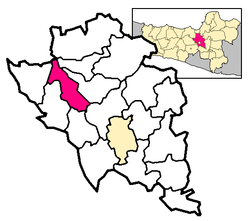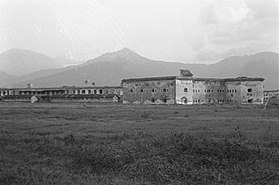
The Indonesian National Revolution, or the Indonesian War of Independence, was an armed conflict and diplomatic struggle between the Republic of Indonesia and the Dutch Empire and an internal social revolution during postwar and postcolonial Indonesia. It took place between Indonesia's declaration of independence in 1945 and the Netherlands' transfer of sovereignty over the Dutch East Indies to the Republic of the United States of Indonesia at the end of 1949.

Central Java is a province of Indonesia, located in the middle of the island of Java. Its administrative capital is Semarang. It is bordered by West Java in the west, the Indian Ocean and the Special Region of Yogyakarta in the south, East Java in the east, and the Java Sea in the north. It has a total area of 34,337.48 km2, with a population of 36,516,035 at the 2020 Census making it the third-most populous province in both Java and Indonesia after West Java and East Java. The official estimate as at mid 2022 was 37,032,410. The province also includes a number of offshore islands, including the island of Nusakambangan in the south, and the Karimun Jawa Islands in the Java Sea.

Prince Diponegoro, also known as Dipanegara, was a Javanese prince who opposed the Dutch colonial rule. The eldest son of the Yogyakartan Sultan Hamengkubuwono III, he played an important role in the Java War between 1825 and 1830. After his defeat and capture, he was exiled to Makassar, where he died, 69 years old.

Semarang is the capital and largest city of Central Java province in Indonesia. It was a major port during the Dutch colonial era, and is still an important regional center and port today. The city has been named as the cleanest tourist destination in Southeast Asia by the ASEAN Clean Tourist City Standard (ACTCS) for 2020–2022.
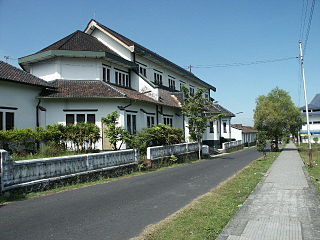
Muntilan is a district (kecamatan) in the Magelang Regency, Central Java. Muntilan is about 15 km south of Magelang, 10 km from Mungkid, 25 km north of Yogyakarta, and 90 km from the main town of Semarang located on the northern coast of Java. The town of Muntilan is on the old railway route between Kebon Polo station in Magelang and the main Tugu station in Yogyakarta. Tourists on their way to the well-known Buddhist temple Borobudur usually pass through Muntilan.

Magelang is one of six cities in Central Java that are administratively independent of the regencies in which they lie geographically. Each of these cities is governed by a mayor rather than a bupati. Magelang city covers an area of 18.12 km2 and has a population of 118,227 at the 2010 census and 121,526 at the 2020 census. It is located in the middle of the Magelang Regency, between Mount Merbabu and Mount Sumbing in Central Java Province, Indonesia, and lies 43 km north of Yogyakarta, 15 km north of Mungkid and 75 km south of Semarang, the capital of Central Java.

The Empire of Japan occupied the Dutch East Indies during World War II from March 1942 until after the end of the war in September 1945. It was one of the most crucial and important periods in modern Indonesian history.

Semarang is a landlocked regency in Central Java province in Indonesia. It covers an area of 1,019.27 km2 and had a population of 930,727 at the 2010 census and 1,053,094 at the 2020 census; the official estimate at mid 2022 was 1,068,492, comprising 532,529 males and 535,964 females. These figures exclude the independent cities of Semarang and Salatiga, which are administratively separate from the regency. The regency's capital is Ungaran, which lies immediately to the south of Semarang City.

The Bulu prison massacre was an incident that took place in Bulu prison, Semarang, Central Java, occurring late in World War II in which over one hundred Japanese POWs were killed by Indonesian forces.

The Ambarawa Railway Museum, is a museum located in Ambarawa in Central Java, Indonesia. The museum preserves around 21 steam locomotives and focusing on tourism train tour hauled by 3 operational steam engines and a hydraulic diesel engine, using the remains of the closing of the 3 ft 6 in (1,067 mm) railway line.

Bersiap is the name given by the Dutch to a violent and chaotic phase of the Indonesian National Revolution following the end of World War II. The Indonesian word bersiap means 'get ready' or 'be prepared'. The Bersiap period lasted from August 1945 to November 1947. In Indonesia, other terms aside from bersiap are commonly used, such as gedoran in Depok, ngeli in Banten and surrounding West Java, and gegeran and dombreng in Central Java.

General of the Army Raden Sudirman was a high-ranking Indonesian military officer during the Indonesian National Revolution. The first commander of the Indonesian National Armed Forces, he continues to be widely respected in the country.
Most railway lines in Indonesia were constructed during the Dutch colonial rule. After independence in 1945, many lines were abandoned. The current national rail operator, PT Kereta Api Indonesia (Persero), was founded on 28 September 1945.

The Battle of Ambarawa was a battle between the recently created Indonesian Army and the British Army that occurred between 20 October and 15 December 1945 in Ambarawa, Indonesia.

The Naamlooze Vennootschap.Nederlandsch-Indische Spoorweg Maatschappij, abbreviated to NIS, NISM or N.V. NISM was private-owned railways company in charge of rail transport in Java, Dutch East Indies. The company's headquarters were in Semarang. The company started its maiden route from Semarang to Vorstenlanden and in 1873 they also built their line to the Willem I Railway Station of Ambarawa–Kedungjati and Batavia–Buitenzorg. Later the network expanded to Bandung and Surabaya. They were the main competitors to Staatsspoorwegen which was state-owned version and it was established on April 6, 1875.
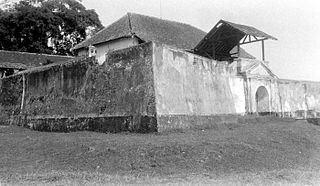
Fort Willem II of Ungaran is a late 18th-century fort built by the Dutch in Ungaran, Semarang Regency, Central Java, Indonesia. Its main purpose was to control an important trade route between Semarang and Yogyakarta. The fort is the place where Prince Diponegoro was imprisoned while waiting for his judgment in Batavia and further exile to Makassar. The fort is currently used as a dormitory for the families of Indonesian police personnel.

Fort Willem I, known in Indonesian/Javanese as Benteng Pendem Ambarawa, is a 19th-century Dutch fortress in Ambarawa, Central Java, Indonesia.

The Battle of Semarang, in Indonesia also known as Pertempuran Lima Hari was a clash between Japanese forces of the Sixteenth Army and Indonesian forces consisting of People's Security Agency personnel and pemuda in October 1945 at the city of Semarang, Central Java. The battle is considered as the first major clash involving the Indonesian military.
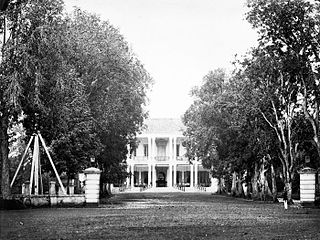
Semarang Residency was an administrative subdivision (Residency) of the Dutch East Indies located on the northern coast of Central Java and named after its capital city Semarang. It existed from 1818 to 1942, although its borders were changed many times during that period.

